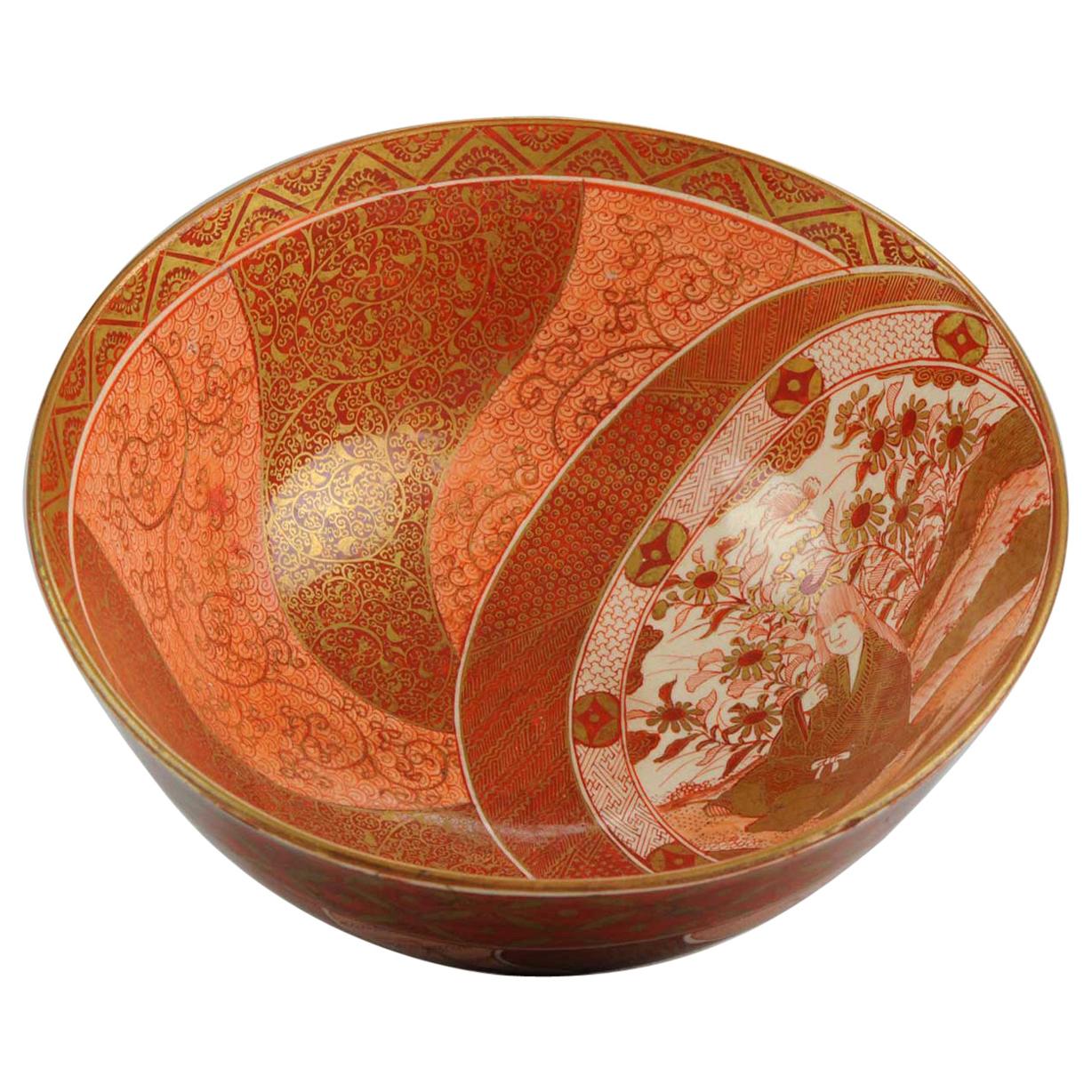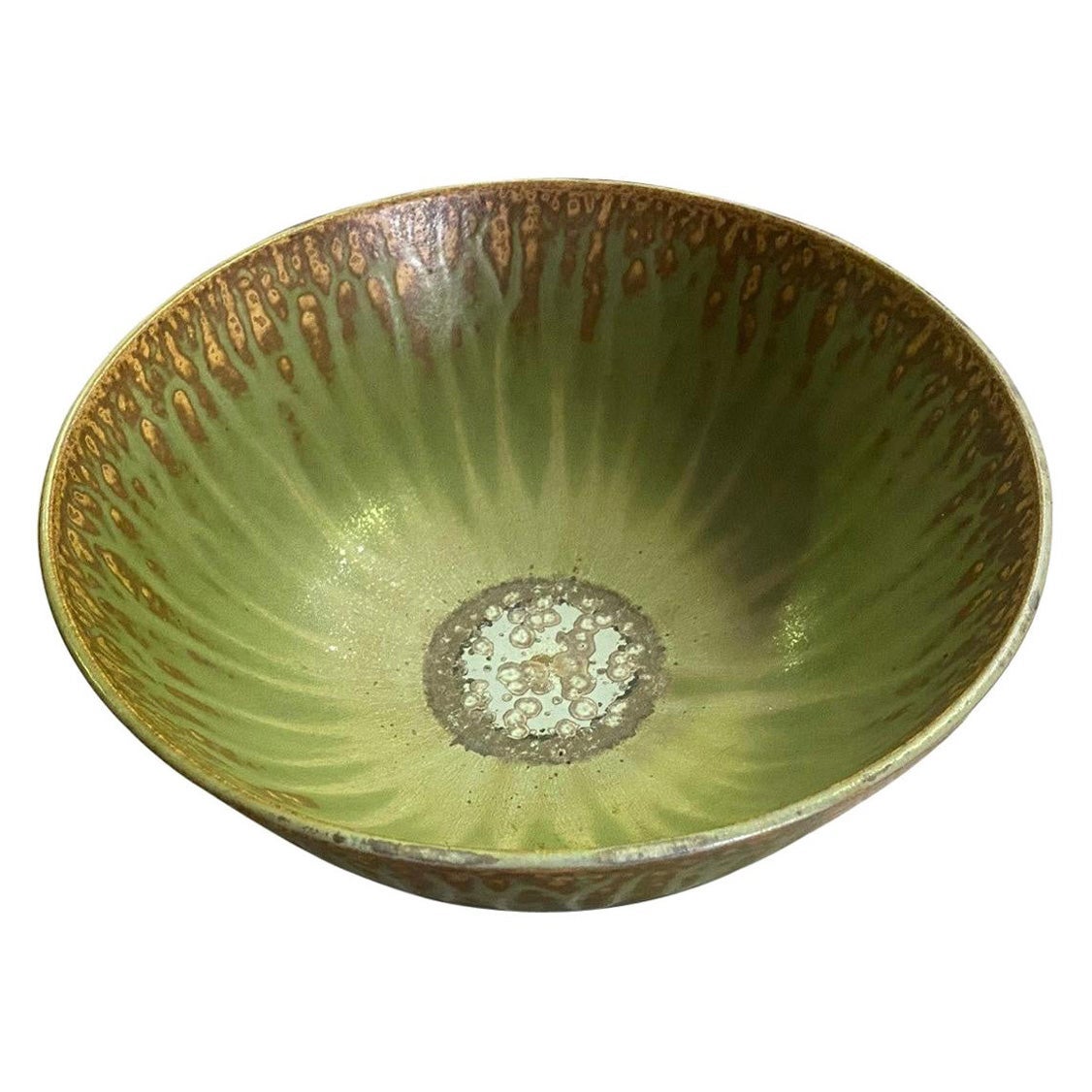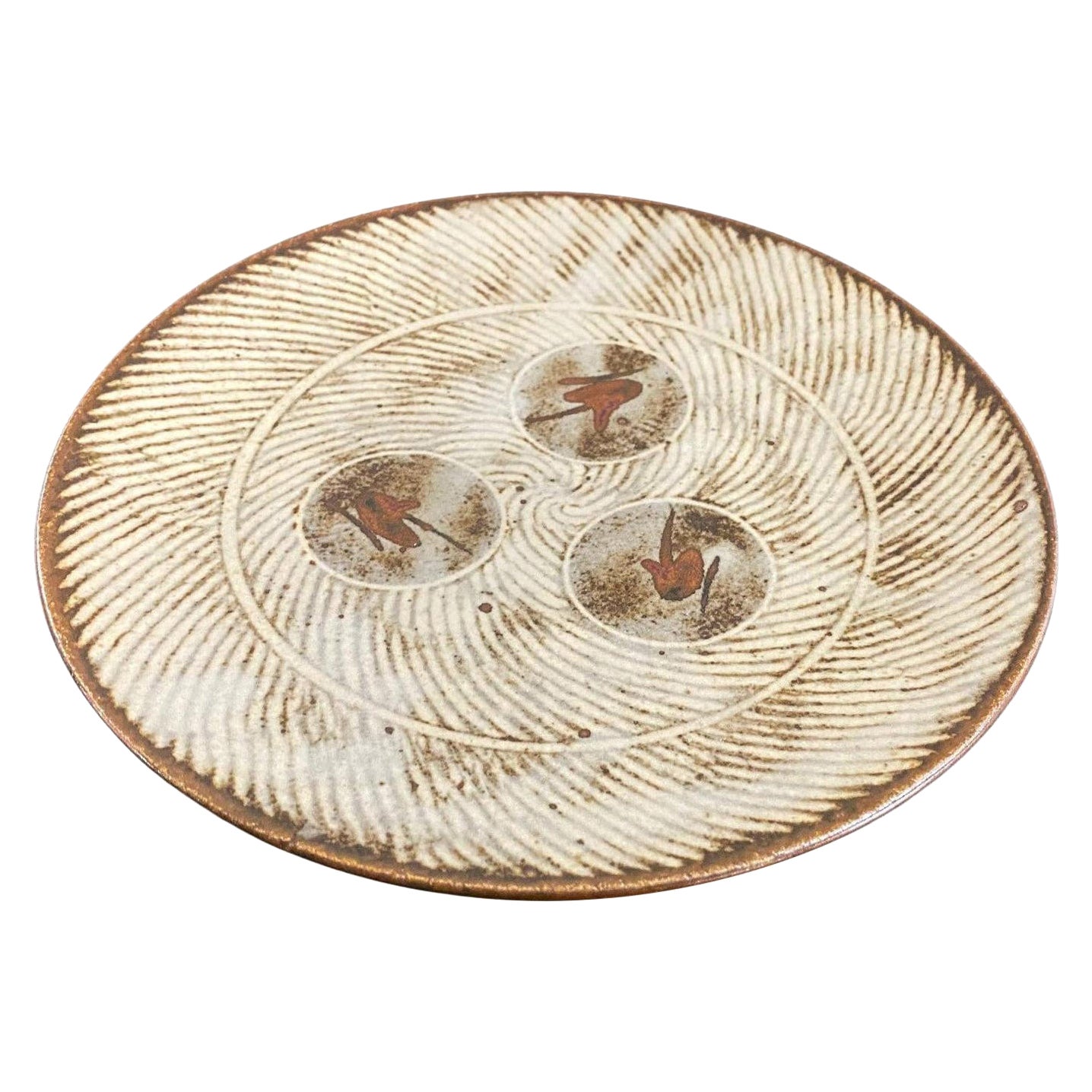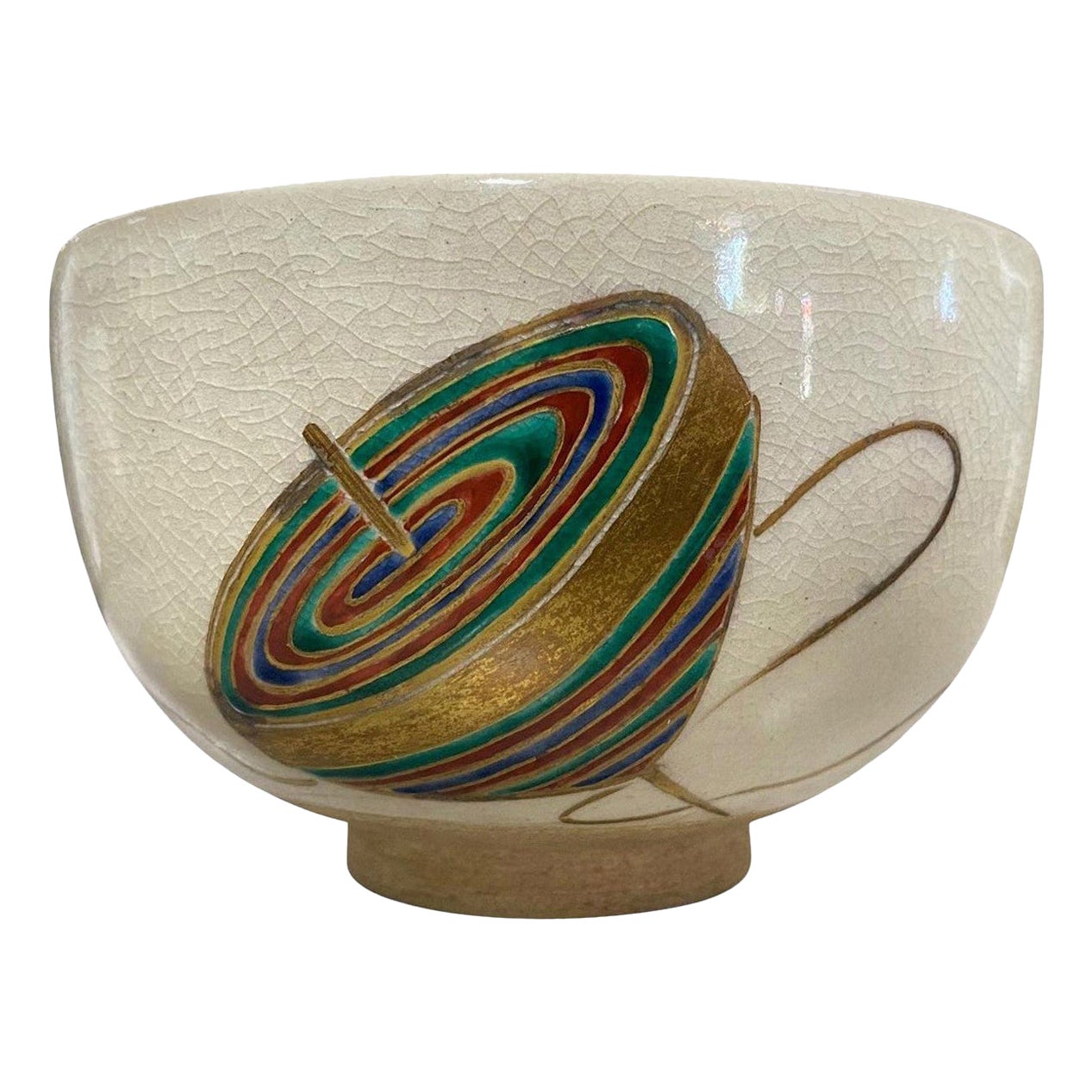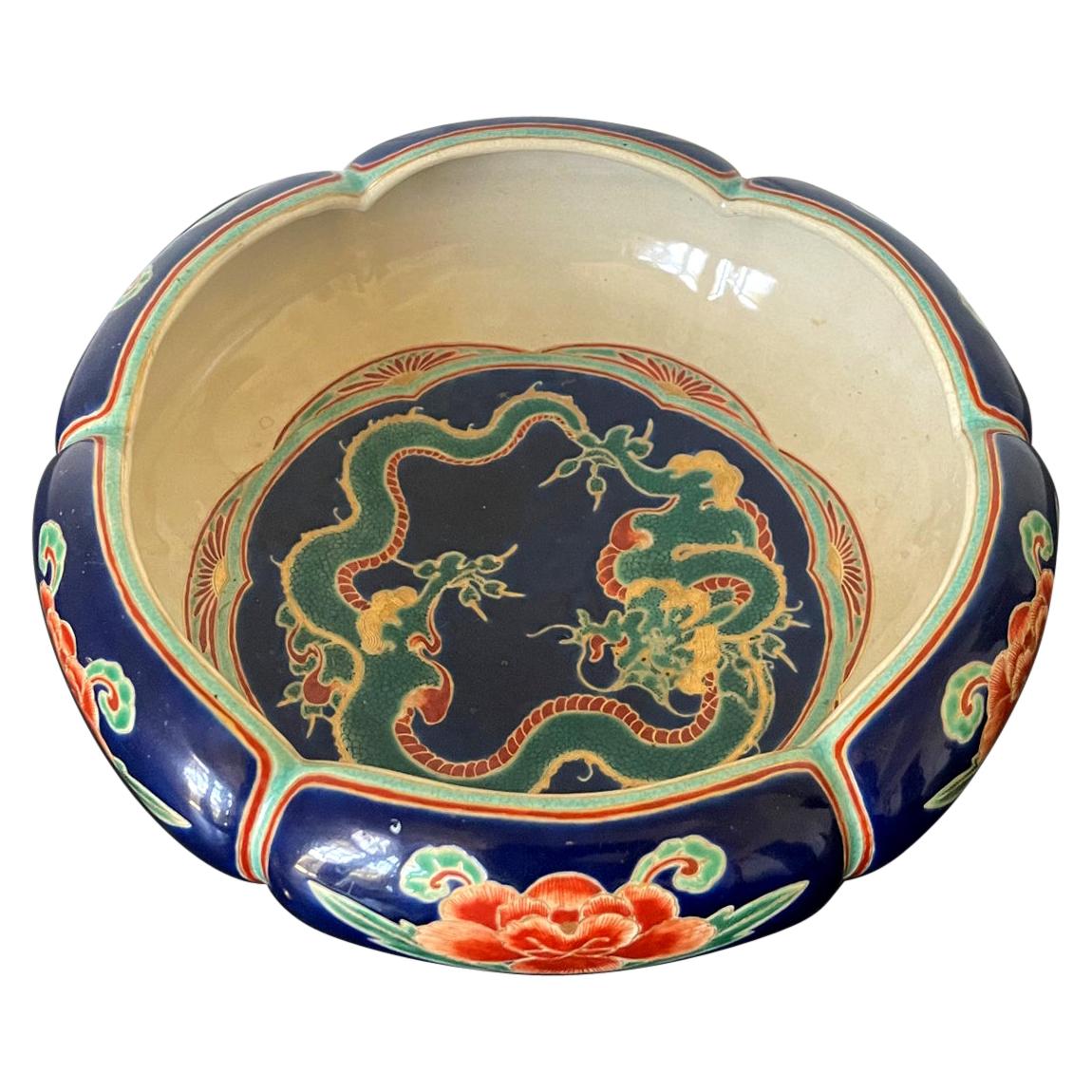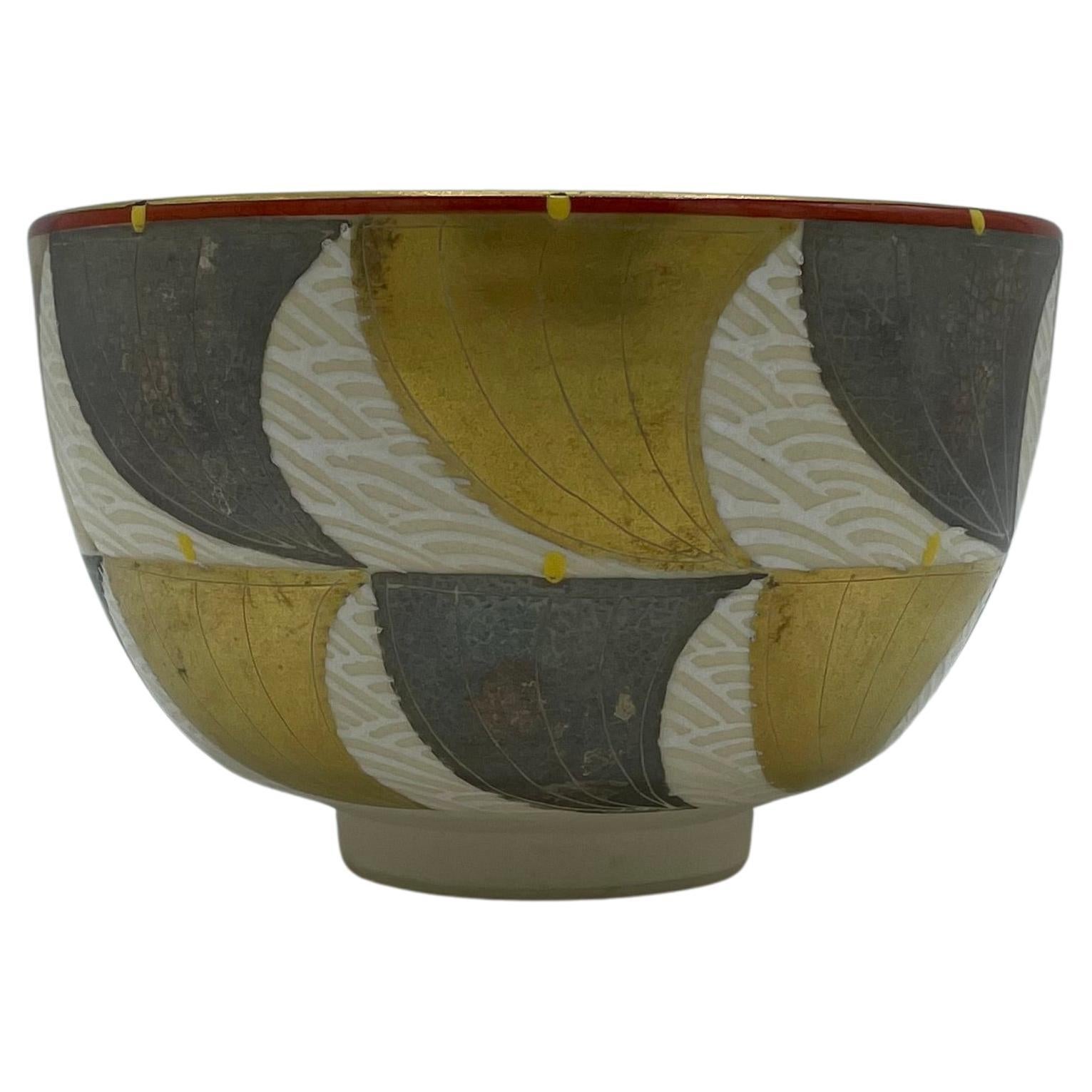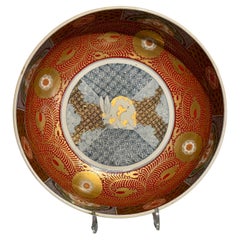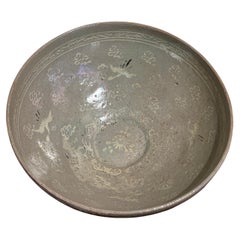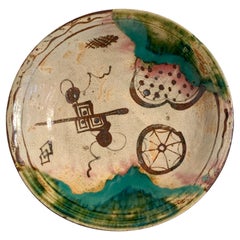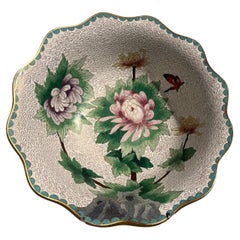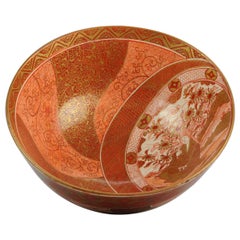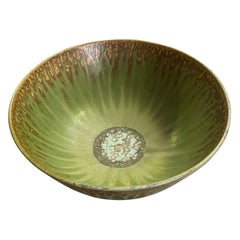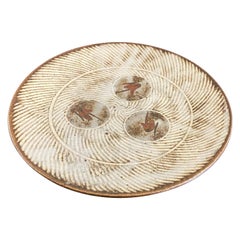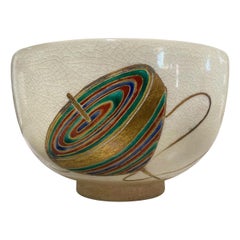Items Similar to Large Vintage Minoyaki Kozan Gamma Op-Art Bowl, Showa Era, 1970's, Japan
Want more images or videos?
Request additional images or videos from the seller
1 of 12
Large Vintage Minoyaki Kozan Gamma Op-Art Bowl, Showa Era, 1970's, Japan
$1,750
£1,336.12
€1,543.87
CA$2,456.67
A$2,738.21
CHF 1,436.65
MX$33,438.05
NOK 18,191.07
SEK 17,193.33
DKK 11,522.59
About the Item
A wild and fantastic vintage Japanese Minoyaki Kozan Gama scalloped rim porcelain bowl, Showa Era, circa 1970's, Japan.
The large and heavy porcelain bowl measures 10" in diameter, and features an intricate and detailed pattern based off of Persian Islamic geometric patterns. The geometric patterns are comprised of and form floral motifs, including stylized blossoms and petals. Variations in the sizes of the geometric motifs add a sense of motion to the piece and create a sense of depth.
Enamels of light and dark blue, orange red, and green, along with rich gilding cover the bowl. The colors harmonize and contrast nicely with each other. The rim of scalloped design and gilt.
The underside signed with a three character mark for Kozan Gama, all within a colorful geometric border.
Kozan Gama was the kiln/brand used by the Maebata China Corporation for their higher end and more intricately decorated pieces.
- Dimensions:Height: 3.75 in (9.53 cm)Diameter: 10 in (25.4 cm)
- Style:Showa (Of the Period)
- Materials and Techniques:
- Place of Origin:
- Period:
- Date of Manufacture:1970's
- Condition:Wear consistent with age and use. No condition issues noted.
- Seller Location:Austin, TX
- Reference Number:1stDibs: LU894743516742
About the Seller
5.0
Platinum Seller
Premium sellers with a 4.7+ rating and 24-hour response times
Established in 2001
1stDibs seller since 2010
345 sales on 1stDibs
Typical response time: <1 hour
- ShippingRetrieving quote...Shipping from: Austin, TX
- Return Policy
Authenticity Guarantee
In the unlikely event there’s an issue with an item’s authenticity, contact us within 1 year for a full refund. DetailsMoney-Back Guarantee
If your item is not as described, is damaged in transit, or does not arrive, contact us within 7 days for a full refund. Details24-Hour Cancellation
You have a 24-hour grace period in which to reconsider your purchase, with no questions asked.Vetted Professional Sellers
Our world-class sellers must adhere to strict standards for service and quality, maintaining the integrity of our listings.Price-Match Guarantee
If you find that a seller listed the same item for a lower price elsewhere, we’ll match it.Trusted Global Delivery
Our best-in-class carrier network provides specialized shipping options worldwide, including custom delivery.More From This Seller
View AllLarge Japanese Imari Rabbit Bowl, Meiji Period, mid 19th Century, Japan
Located in Austin, TX
An impressive and large Japanese Imari bowl with a golden spotted hare or rabbit, early Meiji Period (1864 to 1912), mid 19th century, Japan
The fantastic Imari bowl featuring a c...
Category
Antique Mid-19th Century Japanese Meiji Ceramics
Materials
Porcelain
Korean Goryeo Celadon Glazed Sangam Inlaid Bowl, 12th/13th Century, Korea
Located in Austin, TX
A charming Korean celadon glazed stoneware bowl with white and black sangam inlay, Goryeo Dynasty, 12th - 13th century, Korea.
The celadon glazed stoneware bowl of generous propor...
Category
Antique 15th Century and Earlier Korean Ceramics
Materials
Stoneware
Japanese Ao-Oribe Glazed Stoneware Dish, Early Edo Period, 17th Century, Japan
Located in Austin, TX
A fine and rare Japanese ao-oribe glazed minoyaki stoneware dish, late Momoyama or early Edo period, 17th century, Japan.
The circular dish of wheel thrown ...
Category
Antique 17th Century Japanese Edo Ceramics
Materials
Stoneware
Large Vintage Chinese Cloisonne Scalloped Rim Bowl, circa 1950's, China
Located in Austin, TX
A large and attractive vintage Chinese white ground cloisonne scalloped rimmed bowl, mid 20th century, circa 1950's, China.
The large vintage cloisonne bowl of generous proportions,...
Category
Vintage 1950s Chinese Qing Decorative Bowls
Materials
Copper, Enamel
Large Japanese Imari Charger 16", Edo / Meiji Period, mid 19th century, Japan
Located in Austin, TX
A large and charming Japanese imari charger with Chinese boys, Edo to Meiji Period, mid 19th century, Japan.
The large porcelain charger measuring 16" in diameter features high, slo...
Category
Antique 1860s Japanese Meiji Ceramics
Materials
Porcelain
Large Japanese Lacquer Pedestal Bowl and Cover with Mon, Meiji Period, Japan
Located in Austin, TX
A large Japanese black lacquer and maki-e lacquer decorated footed pedestal bowl and cover featuring the Fujiwara mon, Meiji Period, circa 1900, J...
Category
Antique Early 1900s Japanese Meiji Decorative Bowls
Materials
Lacquer
You May Also Like
Antique 19th Century Japanese Kutani Bowl Marked on Base Figures Garden
Located in Amsterdam, Noord Holland
Large and very lovely piece. With mark
Condition
Overall condition 1 restored chip. Size: 235mm x 100mm
Period
Meiji Periode (1867-1912).
Category
Antique 19th Century Japanese Meiji Ceramics
Materials
Earthenware
$707 Sale Price
20% Off
Arne Bang Signed Monumental Midcentury Danish Scandinavian Ceramic Pottery Bowl
By Arne Bang
Located in Studio City, CA
A wonderful and rare large work by Danish designer Arne Bang. Truly special.
Beautifully glazed and signed with artist mark and number on the base.
Would be a great addition to...
Category
Early 20th Century Danish Mid-Century Modern Ceramics
Materials
Ceramic
Tatsuzo Shimaoka Signed Japanese Mingei Rope Inlay Ceramic Pottery Bowl Plate
By Tatsuzo Shimaoka 2
Located in Studio City, CA
An exquisitely decorated and wonderfully executed ceramic Mingei glazed plate/ low bowl by Japanese National Treasure and Mashiko pottery master Tatsuzo Shimaoka. This work displays his famous Jomon Zogan rope inlay design, hand-painted decoration, and has his impressed "Ta" signature on the base.
Shimaoka, who started as an apprentice to famed Japanese potter Shoji Hamada in 1946 before opening his pottery studio, has exhibited worldwide including in North America, Asia, and Europe. In 1996 he was bestowed the title of Japanese Living Treasure...
Category
Mid-20th Century Japanese Showa Ceramics
Materials
Earthenware
Shiko Shikou Munakata Rare Signed Japanese Pottery Chawan Tea Bowl & Signed Box
By Shiko Munakata
Located in Studio City, CA
An exceptionally rare, wonderfully designed Chawan tea bowl by famed Japanese master woodblock printmaker/ artist Shiko Munakata (1903-1975) who is widely considered to be the most important Japanese visual artist of the 20th century and the Pablo Picasso of Japan. This hand-painted work clearly illustrates Munakata's whimsical side as it is of a Koma - a child's spinning top toy. Very few examples of Munakata's work in ceramics exist still today.
The work is signed by Munakata on the base as well as the original wood protective storage box (his seal can also be seen faintly in the lower-left corner).
The bowl has a small kintsugi or "golden joinery" repair - the Japanese art of repairing broken pottery by mending the areas of breakage with lacquer dusted or mixed with powdered gold - on the inside. As a philosophy, it treats breakage and repair as part of the history of an object, rather than something to disguise.
Munakata who is often compared to Picasso was primarily associated with and a principal figure in both the Sosaku-Hanga (which stressed the artist as the sole creator ) and the Mingei (folk art) movements. His many accolades and awards include the "Prize of Excellence" at the Second International Print Exhibition in Lugano, Switzerland in 1952, and first prize at the São Paulo Bienal Exhibition in Brazil in 1955, followed by the Grand Prix Award at the Venice Biennale in 1956, and the Order of Cultural Merit, the highest honor in the arts by the Japanese government in 1970. In 1960 after returning from a year abroad exhibiting his work in the United States, the Horinji Temple in Kyoto bestowed upon him the honorary rank of “Hokkyo”. In 1962, he received the rank of “Hogan” from Nisseki Temple in Toyama prefecture. He also received a Medal of Honor in 1963 and the Asahi Shimbun culture prize in 1965.
Munakata's work can be found in numerous international collections and museums including:
The Britsih Museum, UK
The Chicago Art Institute
Museum of Modern Art (MOMA), NY
The Metropolitan Museum of Art (The Met), NY
The Philadelphia Museum of Art
The Smithsonian American Art Museum (SAAM), Washington DC
Kemper Art Museum, St. Louis
And his own museum The Munakata Shiko...
Category
Mid-20th Century Japanese Showa Ceramics
Materials
Ceramic
Rare Japanese Ceramic Glazed Bowl Makuzu Kozan Meiji Period
By Makuzu Kozan
Located in Atlanta, GA
On offer is a rare ceramic bowl with overglazed design by the famed Japanese ceramic artist Makuzu Kozan (1842-1916), circa 1906-1916. The bowl is rather unusual from the potter's repertoire with its unique glaze colors and decoration, and it likely belonged to a small series that Kozan made in and after 1906. A bowl of similar glaze and nearly identical dragon motif was recorded as a diplomatic present to the British royalty Arthur Connaught (1883-1932) when he represented King Gorge V in Japan in 1906. Other pieces, such as this bowl, were likely made with similar materials and designs afterwards.
Essentially round in form, the bowl has a generous volume with six harmonious lobes. The bottom of the interior showcases a coiled dragon in red, green and gold slithering on a cobalt blue background. The roundel shares an echoing lobed perimeter, which is further outlined by red and turquois bands and rising sun design. The exterior of the bowl features six stylized Japanese camellias...
Category
Antique Early 1900s Japanese Japonisme Ceramics
Materials
Ceramic
Japanese Porcelain Matcha Bowl for Tea Ceremony Kyo Ware Toraku MORISATO
Located in Paris, FR
This is a bowl that we use during tea ceremony. This is made with porcelain and it was made around 1980 in Showa era. This bowl has a style Kyo raku. It is called Kyo ware and it was...
Category
Vintage 1980s Japanese Showa Decorative Bowls
Materials
Porcelain
More Ways To Browse
1970s Japan Furniture
Op Art 1970s
Japanese Bowl Signed
Retro Islamic Art
Japanese Blue Bowl
Large Enamel Bowl
Retro Scalloped Bowl
Porcelain Covered Bowl
Vintage Chinese Bowl
Vintage Japanese China Patterns
Japanese Floral Bowl
Vintage Blue Enamel Bowl
Persian Enamel
Chinese Covered Bowl
Japanese Enamel Bowl
Islamic Enamel
Large Porcelain Asian Bowl
Persian Bowl
